The Lenovo ThinkPad X1 Carbon Review (2015)
by Brett Howse on May 21, 2015 8:00 AM EST- Posted in
- Laptops
- Lenovo
- ThinkPad
- Ultrabook
- Broadwell-U
Display
Lenovo offers two display choices in the X1 Carbon, with a 1920x1080 model as the base option, and a 2560x1440 available with or without touch. While the resolution of the base panel is fine, the fact that it is a TN panel is not, so I would avoid that if at all possible. Thankfully the step up to the higher resolution model for $150 also gets you an IPS panel. With many devices that I see, there are some questionable decisions made, and I think the TN panel on a $1000+ Ultrabook is the one on this device.
Luckily Lenovo shipped the IPS panel for review. It is a 14-inch panel with a full RGB stripe. In the hardware ID the panel is just labeled as Lenovo, so I can’t say for sure who makes this panel. This model also has the touch digitizer. Despite that, it has almost a matte coating applied to it, or at least the anti-reflective coating is quite effective. This display also came with a built in ICC profile, so it was tested with that ICC being used.
To test the display characteristics, we use SpectraCal's CalMAN 5 suite along with the X-Rite i1Display Pro colorimeter for brightness and contrast readings, and the X-Rite i1Pro spectrophotometer for color accuracy testing.
Brightness and Contrast
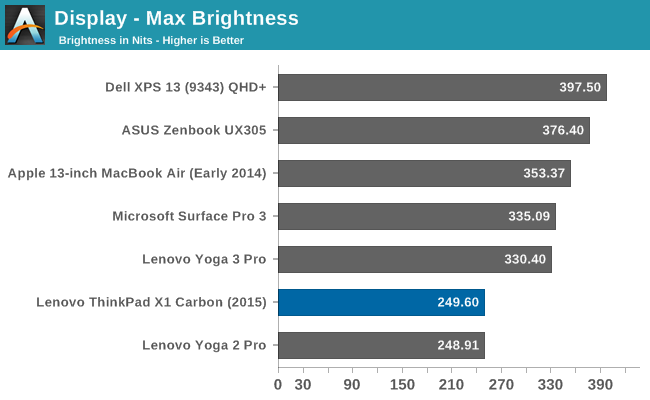
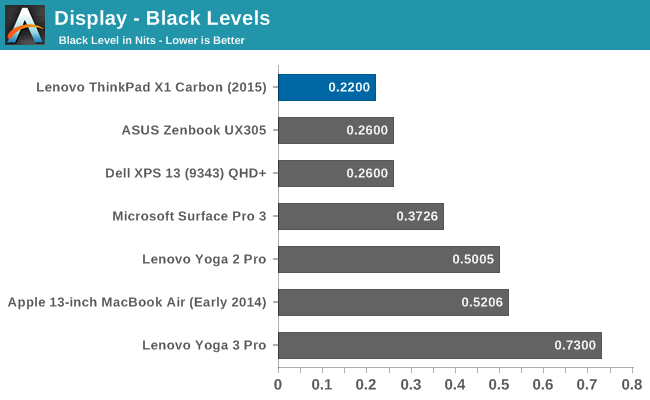
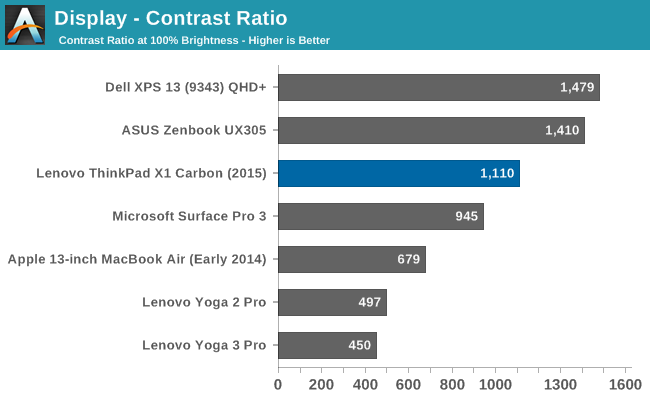
At 250 nits, the X1 Carbon does not get as bright as much of the competition. In fact, to do the color calibration steps, we set the display to 200 nits which is 92% in the power settings of this device. However black levels are quite good, so the overall contrast ratio is still a respectable 1100:1.
Grayscale
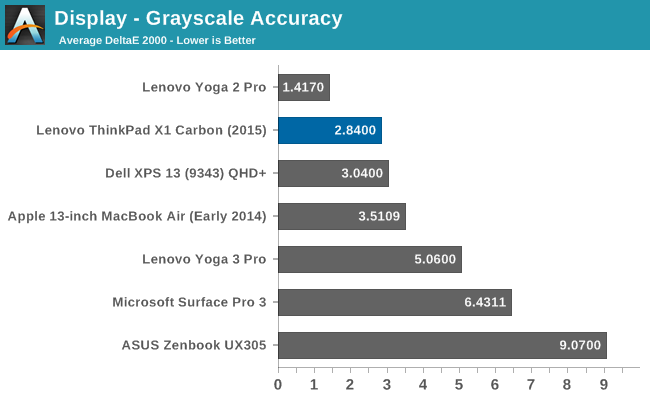
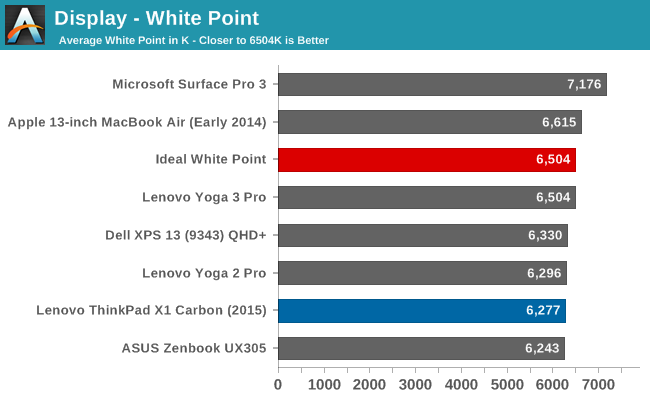
With an average score under three, the grayscale on the X1 Carbon is quite good. The errors do get a bit higher though as the brightness increases, and 100% white actually has a dE of over 5. Gamma drops down quite a bit at the higher brightness levels, and the overall gamma is just 2.0, and the target is 2.2.
Saturation

Saturation accuracy was decent on this display with an overall error level of 3.5, as an average over all of the readings. It is not the best display, but it is far from the worst. It is really the reds that drift off the most.
GMB
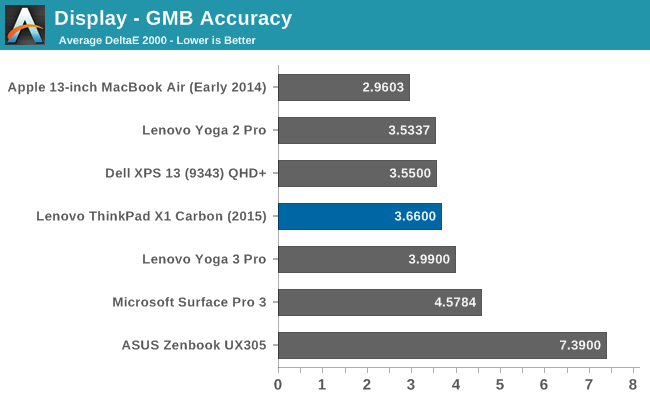
The Gretag Macbeth is the most comprehensive of the tests, and it tests quite a few colors including a lot of the flesh tones. The overall score is once again a good, but not great result, at 3.66.
The overall display is really just average, with no really standout features. The brightness is a bit low, but the contrast is good. Colors are off, but not dramatically. Out of curiosity, I also tested the display without the ICC profile as well, and surprisingly it did not have much of a change in the results. When a generic ICC profile is used, it can’t take into account variability in the individual panels.
Generally ICC profiles are the most help to grayscale, so I ran through our calibration to see how much we could improve the panel.
The grayscale sees a significant improvement, with a dE2000 of just 0.454 and gamma is almost spot on a 2.2. This is what calibration should do, so it was great to see the improvement. Unfortunately this only had a mild effect on the color related scores. Without a 3D LUT, there is only so much you can do.
One other thing that I need to mention about the display is that, at least on the sample I received, there was a bit of a twinkle in the display, which was more noticeable on light colors like white. All displays have a bit of this due to the glue and coatings applied, but on the X1 Carbon it was a bit more noticeable than I was used to.
So overall the display is just OK. Back in 2013 when the X1 Carbon first launched, a display of this quality would have been quite welcomed, but as with all things, progress moves forward and expectations get higher with the competition.

















103 Comments
View All Comments
digiguy - Thursday, May 21, 2015 - link
These are ULV CPUs, they will never close the cap with desktops CPUs, even from a couple of generations ago (provided we are speaking of the same line, that is i7). My 3rd gen quad core laptop CPU is much more powerful than this and even my 2nd gen dual core i7 ultrabook is almost on par with this thanks to a higher (35W) TDP. Having said that a comparison with quad core mobile CPUs would be interesting to see the difference with the best ULVs.nerd1 - Friday, May 22, 2015 - link
If you don't utilize more than 3 cores (few application does) they are actually comparable.Valantar - Thursday, May 21, 2015 - link
Great review! It's good to see how this ultra high end ultrabook is evolving alongside others, even if it still has some of the same issues as before.Now, could you, beg, borrow or steal a similarly specced X250 from Lenovo for comparison? It's an interesting parallell between the two, with the X1 Carbon having a larger screen, m.2 storage and slimmer build, while the X250 is more upgradeable (SODIMM RAM! up to 16GB!), has an intriguing battery solution (both an internal 23.2WHr and a replaceable 23.2-72WHr one, for a total 46-95WHr(!) capacity) and is of course slightly cheaper. I'd love to see an Anandtech review of the follow-up to my beloved X201.
vision33r - Thursday, May 21, 2015 - link
Imo, Lenovo killed Thinkpads today because of shoddy quality and poor software. To allow even malware to their factory software and driver builds tells you they are not thinking about quality.Dells and HP corporate level hardware is better today than Lenovo. Because the BIOS and software provided by HP and Dell are simpler and more stable. There are too many issues with Lenovo firmware and BIOS today. Out of 150 that we received, probably 7-8 will have stability problem using a Windows 8.1 Gold image that we deploy tells you something.
Hulk - Thursday, May 21, 2015 - link
I bought a Lenovo t450s a few months ago and have been very happy with it.And yes it was loaded with tons of crap. I just wiped it and started over. Now it's nice and clean.
BMNify - Thursday, May 21, 2015 - link
Lenovo thinkpad desktop and laptops and other enterprise machines were never loaded with adware, it was a consumer line problem which was rectified. The fact that you have to resort to blatant 100% lies completely invalidates your rant against Lenovo.chizow - Thursday, May 21, 2015 - link
We've had a few X1 Carbons come through, and while it is a solid piece of hardware, just be ready for UEFI and various other issues due to the lack of built-in network adapter if you are using/deploying it in an enterprise environment. Had to work through a few issues with our PXE server and UEFI boot as well, but nothing too bad.Overall Lenovo have been solid for us, lots of X230/X240 in our environment, the only major complaint I have is the amount of overlay/proprietary bloat Lenovo has to use basic functions like WiFi, BT, projectors.
Personally, I vastly prefer Dell Latitude series, especially the latest E7250 and E7250. Amazing keyboards, I've always preferred Dell's keyboards even compared to MacBook chiclets, but now you get the same Dell feel with full chiclet keys.
GeorgeH - Thursday, May 21, 2015 - link
? All X1s have both wired and wireless network adapters.wintermute000 - Thursday, May 21, 2015 - link
I hate it how my T440 has a bloody ultrabook CPU (and still hasn't got anywhere near macbook type battery life). VMs grind it to a halt.I would trade a bit of weight for more battery / a real CPU any time, the company offered an X1 or a T440 and I picked the latter thinking I'd get a real CPU but nope, same ultrabook form over function rubbish
mdvision - Thursday, May 21, 2015 - link
I am both an HP and Lenovo authorized business partner. I have to agree with some other posters that the HP Elitebook line has been superior in build, design and warranty response. My personal device of choice for the last couple of years has been the HP Folio 9480m ultrabook. Battery time is decent....not spectacular but more importantly is user replaceable and there is an optional secondary slice battery option that while adding a bit of thickness and weight provides REAL all day run time. RAM is conventional SODIMM's and serviceable / upgradable as well.My current model has an I7 4600U ULV CPU, 8GB RAM, 256GB SSD, 1600x1200 matte display. The display resolution is fine on a 14" display and scales well using Win8.1 Pro. Performance does not lack (gaming excepted of course). I change my demo unit out every quarter or so and keep replacing with the same unit. This is a great device. Warranty response on HP Elitebook products have been nothing but exemplary on the very few units I've had to do warranty claims. RMA turn around times are very fast as in days not weeks. Technical support personnel have been knowledgeable and professional.
Field serviceable batteries, RAM, HD's are important enough that any minimal weight savings are more than offset rather than having the thinnest / lightest device that requires factory servicing for routine maintenance / repair.
I also have these deployed with the optional docking station which have performed flawlessly using external displays, peripherals and charging. Smart Buy configurations are competitively priced and offer good value. Highly recommended.
I've previously considered the X1 Carbon but the above design features always sway me back to the HP.